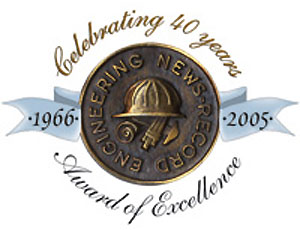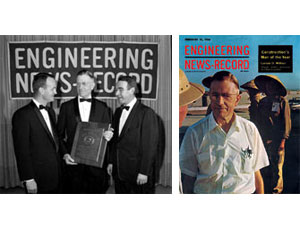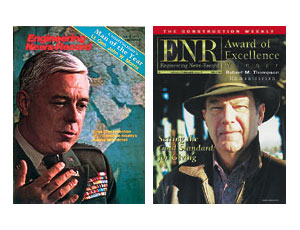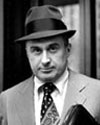Arthur J. Fox was contemplating changes to ENR during his first year as editor-in-chief. Noting that Aviation Week, another McGraw-Hill publication, published an annual feature entitled "Laurels for Last Year," citing individuals who made worthwhile contributions to the aviation industry, Fox felt construction could benefit from its own list of notables.




ARTHUR J. FOX
ENRs effort debuted in the Jan. 23, 1964, issue, under the headline, "Some Men Who Made Marks in 63." It included Morris Beutel, an early advocate of computers for critical path scheduling and estimating. Even President John F. Kennedy made the list, for enacting a $1.2-billion program to aid construction of college buildings.
Two years later, Fox expanded the awards program by recognizing one "marksman" who had, in the editors opinion, made the most significant contribution to the industry during the previous year. The first ENR "Man of the Year" was Lyman Dwight Wilbur of Morrison Knudsen, who managed the vast contracted military construction effort in Vietnam. The award was given at a dinner at New Yorks Pierre Hotel attended by 350 top industry executives and others.
Until that time, the only events at which engineers and constructors were nationally recognized were those sponsored by two industry groups, the Beavers and the Moles.
The ENR awardees reflect the tremendous challenges tackled by the industry. Some have been recognized for managing megaprojects, such as Frank P. Moolin Jr. in 1976 for the Trans-Alaska Pipeline, Robert A. Boyd in 1981 for Quebecs James Bay power project, and Jack Lemley for the massive Channel Tunnel, in 1991.
Three award winners are associated with New Yorks landmark World Trade Center. Ray M. Monti was cited as its project manager in 1971; Leslie E. Robertson, its structural engineer, was cited in 1989; and Michael Burton received the award in 2002 for managing site cleanup following its destruction on Sept. 11, 2001.
Others have led efforts to build badly needed housing or schools, including James W. Rouse, in 1985, who pioneered urban marketplaces to fund the rebuilding of slums. Kathi Littmann was recognized in 2003 for kickstarting Los Angeles dormant school building program.
Several winners have forged ahead courageously, even through threats of violence. Vinton W. Bacon fought graft in Chicagos sewer agency in 1967 despite an attempt on his life. J. Leon Altemose fought to be an open-shop contractor, in the face of intimidation by militant unionists.
Some have been reformers. Thomas D. Larson transformed the Pennsylvania Dept. of Transportation in 1982. It had been a patronage machine that performed abysmally. Marwan M. Sadat, in 1986, energized New Jerseys Superfund work while other states lagged behind.
A number of winners participated in the push by major U.S. firms to enter the international marketplace. In 1977, Lt. Gen. John W. Morris, a former commander of the Corps of Engineers, managed the explosive effort to build $20 billion worth of Saudi Arabias military infrastructure. J. Robert Fluor in 1980 applied U.S. know-how to South Africas synfuels production.
Social changes over the years affected the makeup of ENR dinner attendees. Early gatherings were virtually all-male. As more women rose in the industrys ranks, they began attending the dinner in greater numbers and were named as "those who made marks." Ginger S. Evans was named ENRs first-ever Woman of the Year in 1994 for cutting through politics and red tape to build Denver International Airport. She also received the first ENR Award of Excellence, as the award was renamed.
Winners began to reflect technological changes. William B. Derrickson won in 1984 for delivering the St. Lucie 2 nuclear powerplant in six years, half the standard. But Leo P. Duffy was cited in 1993 for cleaning up the unfortunate legacy of the U.S. nuclear weapons program. John G. Voeller was cited in 1999 for riding herd on cutting-edge information technologies in construction that did not exist a decade earlier.
Attendance has grown steadily, to this years crowd that reaches 1,500, a testament to its preeminence as a construction industry event. Importance of the Marksmen, now called Newsmakers, also has grown. Since 1993, editors have limited newsmaker selection to 25 individuals. In 2001, ENR introduced a luncheon awards program to better recognize their achievements.
Constructions landscape has evolved in terms of project delivery choices over the past several decades. Hard-money contracting was prevalent during the 1960s and 1970s. Bit by bit, more jobs became performance-based, and construction management grew.
"In those days, you bid the specific job to be done," says Morris. "In recent years off the shelf, no-bid contracts have become common."
Other AOE winners note industry changes, including the impact of computers. "Many structures today would not exist without the enhancement of computers," says James W. Poirot, who won in 1988.
Robert M. Thompson won in 2000 for sharing proceeds from the sale of his paving firm with employees. He notes the increased pressure on revenue and profits but admits the lure of the construction business. Thompson retired in 1999 to continue his philanthropy. But he returned, recently buying two sizable ready mix firms and is back in business.


Post a comment to this article
Report Abusive Comment